Selection Criteria
We seek to include a wide range of documents in the present database project. The selection criteria are not based on exclusion, but rather aim at following certain categories of preference which can be outlined as follows:
Linguistic and geographical range
Persian should not be understood as a rigid linguistic specification, but rather as a cultural characteristic. It therefore does not only refer to Persian as a language, but equally to Persia in the geographical and historical sense. Therefore, early private documents written in Arabic will be included, as well as documents in other languages as long as a clear connection to Persian cultural influence can be determined. Only by way of exception, however, shall western archival material in languages such as English, Latin or French be taken into account.
The same is true for the geographical range we seek to cover. The core areas are defined by the shifting historical boundaries of Iran, thus including at times regions such as Anatolia, the Caucasus and Middle Asia. Another criterion is the use of Persian as administrative language as in Central Asia or India, although the systematic integration of Indian documents is beyond the project's scope.
Time frame
We will focus on the medieval and early modern periods of Iranian and Central Asian history up to the 20th century, with the general guideline "the older, the more precious". Later material will only be included if it adheres to traditional forms, as in the case of contracts and other private deeds.
Document types
There will be no preference for a certain category of documents, such as favouring royal decrees over private judicial deeds. We prefer however originals over later effected copies, being aware of the sometimes difficult decision of what constitutes an "original", completely preserved deeds over fragments, and dated documents over those where dating is not available or problematic. However, we will at times have to draw a line between documents and manuscripts, and only by way of exception will we include epigraphic material, such as decrees or endowment deeds affixed to buildings.
Sources
We will include both published and unpublished archival material. A decisive criterion of selection is the quality of the available facsimile. It should be possible to work with the document based on the reproduction. A facsimile therefore has to be clearly distinguished from a mere illustration that might look interesting, but is not readable or presents only part of a document. Publications of documents that are not accompanied by a usable facsimile will only be included if their importance is outstanding, since the edition is not easily verifiable and no remarks on formal characteristics can be made.
If the reproduction is accompanied by a text edition, this is a clear plus, but not a condition. In a first step we want to incorporate documents published in older and already completed journals from Iran, such as Farhang-i Iran-zamin or Rahnamah-i kitab. As a general rule, we can also state that the rarer the journal, or the more remote the place of publication, the more important to include published documents.



